This is a list of the most well-known cicadas in North America, including sound files and images. Handy for cicada identifying in the field.
See one of these cicadas in 2024?
Join this 2024 North American Annual Cicada Location Project on iNaturalist and report it.
Annual Cicada Species
These cicadas appear every year.
Cacama valvata (Uhler, 1888)
©Insect Singers.
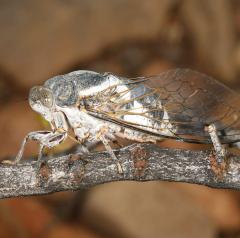
©Adam Fleishman.
- Short Name: C. valvata
- Common Name: Common Cactus Dodger
- Locations: AZ, CA, CO, KS, NV, NM, OK, TX, UT
- When: May-June, peaking in June.
- Eyes: beige and black mix
- Collar: black with gold highlights
- Description: Black with gold highlights and white pruinose.
- More info, photos, sounds, video, and references
Cicadettana calliope calliope (Walker, 1850)
©Insect Singers.
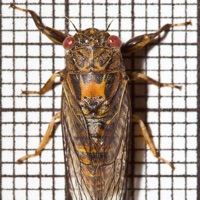
©Paul Krombholz
- Short Name: C. calliope calliope
- Common Name: Southern Grass Cicada
- Locations: AL, AR, CO, FL, GA, IL, IN, IA, KS, KY, LA, MD, MS, MO, NE, NC, OH, OK, SC, SD, TN, TX, VA
- When: May-August, peaking in July.
- Eyes: pink, beige, green
- Collar: rust, brown
- Description: Small. Black and brown.
- More info, photos, sounds, video, and references
Diceroprocta apache (Davis, 1921)
©Insect Singers.
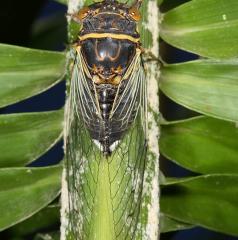
© Adam Fleishman
- Short Name: D. apache
- Common Name: Citrus Cicada
- Locations: AZ, CA, CO, NV, UT
- When: June-September. Peaks in July.
- Eyes: red or beige
- Collar: beige
- Description: Black and beige.
- More info, photos, sounds, video, and references
Diceroprocta olympusa (Walker, 1850)
©Insect Singers.
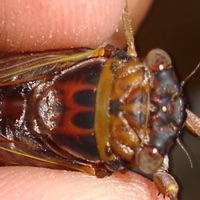
© Joe Green.
- Short Name: D. olympusa
- Common Name: Olympic Scrub Cicada
- Locations: AL, FL, GA, MS, NC, SC
- When: June-August. Peaks in August.
- Eyes: brown?
- Collar: green
- Description: Black, brown, and green with white pruinose.
- More info, photos, sounds, video, and references
Diceroprocta vitripennis (Say, 1830)
©Insect Singers.
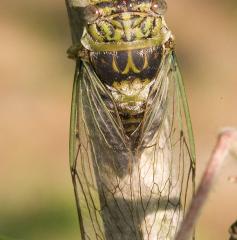
© Paul Krombholz
- Short Name: D. vitripennis
- Common Name: Green Winged Cicada
- Locations: AL, AR, IL, IN, KS, KY, LA, MI, MS, MO, NE, OK, TN, TX, WI
- When: June-August. Peaks in July.
- Eyes: green
- Collar: green
- Description: Black with green and brown and white pruinose.
- More info, photos, sounds, video, and references
Megatibicen grossus
©Insect Singers.
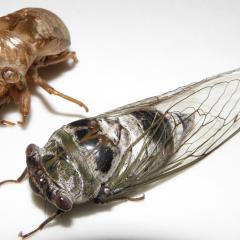
- Short Name: M. grossus
- Former Name: Megatibicen auletes
- Common Name: Northern Dusk Singing Cicada
- Locations: AL, AR, CT, DE, DC, FL, GA, IL, IN, IA, KS, KY, LA, MD, MA, MI, MS, MO, NE, NJ, NY, NC, OH, OK, PA, SC, TN, TX, VA, WV, WI
- When: June-September. Peaks in August.
- Eyes: gray / beige
- Collar: olive or rusty brown
- Description: The largest North American cicada. Olive green to rusty brown with black, tan, and white coloring. Heavy white pruinose. M on mesonotum is typically partially occluded by pruinose. Sings at dusk.
- More info, photos, sounds, video, and references
Megatibicen dealbatus (Davis, 1915)
©Insect Singers.
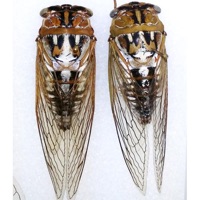
- Short Name: M. dealbatus
- Common Name: Plains Cicada
- Locations: CO, IA, KS, MT, NE, NM, ND, OK, SD, TX, WY
- When: June-October. Peaks in August.
- Eyes: beige
- Collar: light orange or olive
- Description: Primarily either orange/rust or pea green, brown, or black with heavy pruninosity which forms distinct markings on the dorsal side of the body. The dorsal side has two black stripes framed by three areas of pruinosity. Sounds like N. pronotalis.
- More info, photos, sounds, video, and references
Megatibicen dorsatus (Say, 1825)
©Insect Singers.
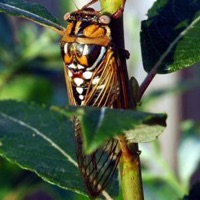
© Bill Lesar
- Short Name: M. dorsatus
- Common Name: Bush Cicada, Grand Western, or Giant Grassland Cicada
- Locations: AR, CO, ID, IL, IA, KS, MO, MT, NE, NM, OK, SD, TX, WY
- When: July-September. Peaks in August.
- Eyes: beige to brown
- Collar: light orange
- Description: Rust/orange, black & white pruinosity, which forms distinct markings, such as a line of white dots down the dorsal side of the abdomen. Sounds like N. tremulus. Has a call that sounds like a rapid series of clicks.
- More info, photos, sounds, video, and references
Megatibicen figuratus (Walker, 1858)
©Insect Singers.
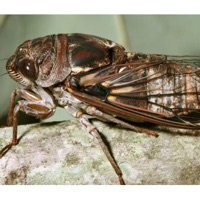
© Paul Krombholz
- Short Name: M. figuratus
- Common Name: Fall Southeastern Dusk-singing Cicada
- Locations: AL, AR, FL, GA, LA, MS, NC, SC, TN, TX, VA
- When: August-October. Peaks in September.
- Eyes: brown
- Collar: brown
- Description: Black and brown. White pruinosis.
- More info, photos, sounds, video, and references
Megatibicen pronotalis walkeri Metcalf, 1955
©Insect Singers.
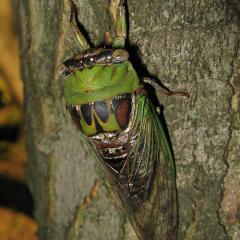
© Roy Troutman
- Short Name: M. pronotalis walkeri
- Common Name: Walker’s Cicada
- Locations: AL, AR, FL, GA, IL, IN, IA, KS, KY, LA, MD, MI, MN, MS, MO, NE, NC, ND, OH, OK, SD, TN, TX, VA, WV, WI, WY
- When: July-September. Peaks in August.
- Eyes: gray
- Collar: green or brown
- Description: Tan or pea green, brown, black, and sometimes white pruinose. Wing color matches the dominant color of the body. Typically lacks a black marking on its pronotum.
- More info, photos, sounds, video, and references
Megatibicen resh (Haldeman, 1852)
©Insect Singers.
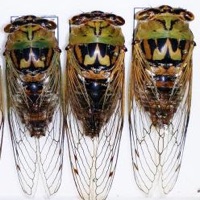
- Short Name: M. resh
- Common Name: Resh Cicada
- Locations: AR, KS, LA, MS, NE, OK, SC, TN, TX
- When: May-October. Peaks in August.
- Eyes: Varies
- Collar: olive
- Description: Black, green, and brown camo pattern. White pruinosis. Resh Hebrew character pattern on mesonotum.
- More info, photos, sounds, video, and references
Megatibicen resonans (Walker, 1850)
©Insect Singers.
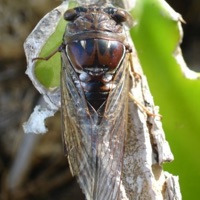
© Joe Green
- Short Name: M. resonans
- Common Name: Southern Resonant/Great Pine Barrens Cicada
- Locations: AL, FL, GA, LA, MS, NC, SC, TN, TX, VA
- When: May-October. Peaks in August.
- Eyes: brown
- Collar: brown
- Description: Brown, black & white pruinosity distinctively present within curves of the cruciform elevation.
- More info, photos, sounds, video, and references
Neocicada hieroglyphica hieroglyphica (Say, 1830)
©Insect Singers.

© Joe Green
- Short Name: N. hieroglyphica hieroglyphica
- Common Name: Hieroglyphic Cicada
- Locations: AL, AR, DE, FL, GA, IL, IN, KS, KY, LA, MD, MS, MO, NJ, NY, NC, OH, OK, SC, TN, TX, VA
- When: May-August. Peaks in June.
- Eyes: varies
- Collar: varies
- Description: Black, brown, and green patterns.
- More info, photos, sounds, video, and references
Neotibicen canicularis (Harris, 1841)
©Insect Singers.
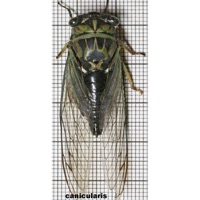
© Paul Krombholz
- Short Name: N. canicularis
- Common Name: Dog-day Cicada
- Locations: AR, CT, DC, IL, IN, IA, KS, ME, MB, MD, MA, MI, MN, MO, NE, NB, NH, NJ, NY, NC, ND, NS, OH, ON, PA, PE, QC, RI, SC, SD, TN, VT, VA, WV, WI
- When: July-September. Peaks in August.
- Eyes: varies
- Collar: varies
- Description: Typical black, brown, beige and green Tibicen camo patterns. The primary color varies from brown to green. The collar is often a mix of green & black. Sounds like an angle grinder tool and like N. auriferus & N. davisi.
- More info, photos, sounds, video, and references
Neotibicen davisi davisi (Smith and Grossbeck, 1907)
©Insect Singers.
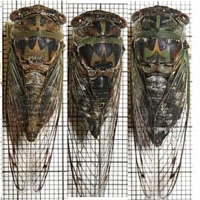
© Paul Krombholz
- Short Name: N. davisi davisi
- Common Name: Davis’ Southeastern Dog-Day Cicada
- Locations: AL, DE, DC, FL, GA, LA, MD, MA, MS, NJ, NY, NC, PA, SC, TN, TX, VA, WV
- When: August-December. Peaks in September.
- Eyes: varies
- Collar: brown or green
- Description: The davisi comes in a wide variety of colors: from rusty browns to greens. A crown-like pattern on the mesonotum. Sounds like an angle grinder tool, & sounds like N. auriferus & N. canicularis.
- More info, photos, sounds, video, and references
Neotibicen latifasciatus (Davis, 1915)
©Insect Singers.
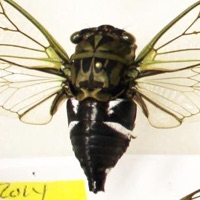
- Short Name: N. latifasciatus
- Common Name: Coastal Scissor(s) Grinder Cicada
- Locations: FL, MD, NJ, NC, VA
- When: August-October. Peaks in September.
- Eyes: brown
- Collar: brown or green
- Description: If the cicada has a white X on its back, it is a latifasciatus. Repetitive, rhythmic, call like someone repeatedly running a scissor over a grinding wheel.
- More info, photos, sounds, video, and references
Neotibicen linnei (Smith and Grossbeck, 1907)
©Insect Singers.
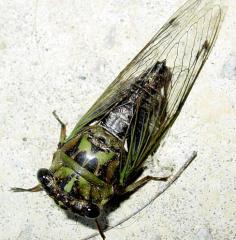
© Tom Lehmkuhl
- Short Name: N. linnei
- Common Name: Linne’s Cicada
- Locations: AL, AR, CT, DE, DC, FL, GA, IL, IN, IA, KS, KY, LA, ME, MD, MA, MI, MN, MS, MO, NE, NJ, NY, NC, OH, ON, PA, SC, TN, VT, VA, WV, WI
- When: July-September. Peaks in August.
- Eyes: dark brown
- Collar: green
- Description: Black, green and some brown camo pattern. Prominent M. Bend in its wing. Sounds like N. tibicen.
- More info, photos, sounds, video, and references
Neotibicen lyricen engelhardti (Davis, 1910)
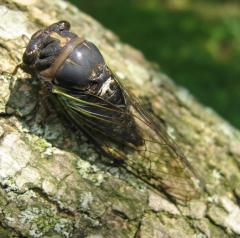
© Roy Troutman
- Short Name: N. lyricen engelhardti
- Common Name: Dark Lyric Cicada
- Locations: AL, CT, DE, DC, FL, GA, IN, IL, KY, MD, MA, MS, NJ, NY, NC, OH, PA, RI, SC, TN, VA, WV
- When: July-September. Peaks in July.
- Eyes: black
- Collar: black
- Description: The Dark Lyric Cicadas have the darkest coloration of all the Lyric cicadas. Their mesonotum is almost entirely dark brown/black. They have a “soda-pop pull-tab” or keyhole shape on their pronotum.
- More info, photos, sounds, video, and references
Neotibicen lyricen lyricen (De Geer, 1773)
©Insect Singers.
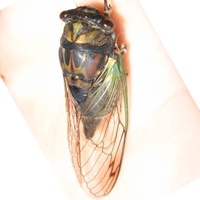
- Short Name: N. lyricen lyricen
- Common Name: Lyric Cicada
- Locations: AL, AR, CT, DE, DC, FL, GA, IL, IN, IA, KS, KY, LA, MD, MA, MI, MS, MO, NE, NH, NJ, NY, NC, OH, OK, ON, PA, RI, SC, TN, TX, VA, WV, WI
- When: June-August. Peaks in July.
- Eyes: brown
- Collar: black
- Description: The Lyric cicada, like most small Neotibicen, has a green, black & brown camouflage look, but the key is Lyric cicadas typically have black collars. Its sound is like an angle grinder tool steadily grinding a slightly uneven surface.
- More info, photos, sounds, video, and references
Neotibicen pruinosus pruinosus (Say, 1825)
©Insect Singers.
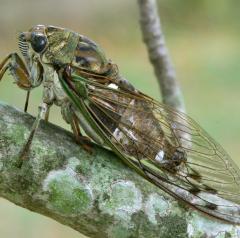
© Paul Krombholz
- Short Name: N. pruinosus pruinosus
- Common Name: Scissor(s) Grinder
- Locations: AL, AR, CO, IL, IN, IA, KS, KY, LA, MI, MN, MS, MO, NE, NC, OH, OK, PA, SC, SD, TN, TX, WV, WI
- When: June-October. Peaks in August.
- Eyes: black
- Collar: green
- Description: The Scissor Grinder looks a lot like Linne’s Cicada but its wing doesn’t have the bend that Linne’s Cicada has. The Scissor Grinder also seems to have more of an orange coloration to the ‘arches’ on its mesonotum.
- More info, photos, sounds, video, and references
Neotibicen superbus (Fitch, 1855)
©Insect Singers.
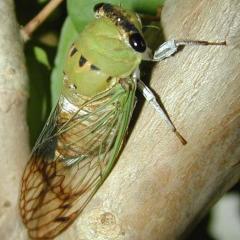
© Sloan Childers
- Short Name: N. superbus
- Common Name: Superb Dog-Day Cicada
- Locations: AR, KS, LA, MO, NM, OK, TX
- When: June-August. Peaks in July.
- Eyes: black
- Collar: green
- Description: Green with black mask and yellow arches on back.
- More info, photos, sounds, video, and references
Neotibicen tibicen tibicen (Linnaeus, 1758)
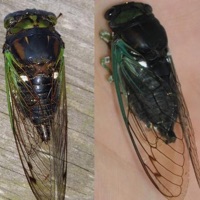
- Short Name: N. tibicen tibicen
- Common Name: Swamp Cicada, Morning Cicada
- Locations: AL, AR, CT, DE, DC, FL, GA, IL, IN, IA, KS, KY, LA, MD, MA, MI, MS, MO, NE, NJ, NY, NC, OH, OK, PA, RI, SC, SD, TN, TX, VT, VA, WV, WI
- When: June-September. Peaks in August.
- Eyes: black or dark green
- Collar: black
- Description: Swamp Cicadas are known for their rounded, humped back. Their coloration varies from mostly black & some green to black, brown, and green. Their collar is usually black but can include green.
- More info, photos, sounds, video, and references
Neotibicen winnemanna (Davis, 1912)
©Insect Singers.
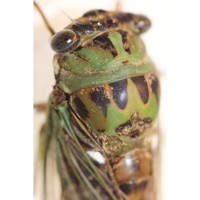
- Short Name: N. winnemanna
- Common Name: Eastern Scissor(s) Grinder
- Locations: DE, DC, GA, MD, NC, NJ, PA, SC, VA
- When: June-September. Peak in September.
- Eyes: dark green
- Collar: green
- Description: Like the Scissor Grinder, the Eastern Scissor Grinder seems to have more of an orange hue to the arches on its mesonotum, perhaps even more so than the Scissor Grinder.
- More info, photos, sounds, video, and references
Okanagana bella Davis, 1919
©Insect Singers.
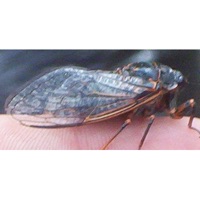
© Matt Berger
- Short Name: O. bella
- Common Name: Mountain Cicada
- Locations: AB, AZ, BC, CA, CO, ID, MT, NV, NM, OR, SD, UT, WA, WY
- When: June-July. Peaks in June.
- Eyes: black
- Collar: orange
- Description: Black with orange highlights.
- More info, photos, sounds, video, and references
Okanagana canadensis (Provancher, 1889)
©Insect Singers.
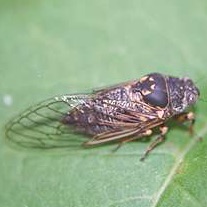
© Les Daniels
- Short Name: O. canadensis
- Common Name: Canadian Cicada
- Locations: AB, BC, CA, CO, ID, ME, MB, MI, MN, MT, NB, NH, NY, NT, OH, ON, OR, PA, QC, SK, SD, UT, VT, WI
- When: June-July. Peaks in June.
- Eyes: dark gray
- Collar: black and beige
- Description: Black with beige highlights.
- More info, photos, sounds, video, and references
Okanagana rimosa rimosa (Say, 1830)
©Insect Singers.
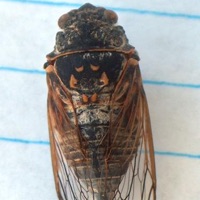
© Natasha
- Short Name: O. rimosa rimosa
- Common Name: Say’s Cicada
- Locations: AB, BC, CA, CT, ID, IL, IN, IA, ME, MB, MD, MA, MI, MN, MT, NV, NB, NH, NJ, NY, ND, OH, ON, OR, PA, QC, SD, UT, VT, VA, WA, WI, WY
- When: May-July. Peaks in June.
- Eyes: Varies
- Collar: orange
- Description: Black body with orange highlights
- More info, photos, sounds, video, and references
Pacarina puella Davis, 1923
©Insect Singers.
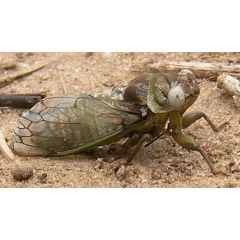
© John Beard
- Short Name: P. puella
- Locations: AZ, LA, OK, TX
- When: May-July. Peaks in June.
- Eyes: light
- Collar: varies
- Description: Tiny. Varies: brown, green, black, etc.
- More info, photos, sounds, video, and references
Platypedia spp.
Source: ©Insect Singers | Species: P. putnami putnami

© CGWiber
- Common Name: Wing Clapping Cicadas
- Locations: West of the Mississippi. Often found near water, and is a favorite of fly fishers.
- When: April-July. Peaks in June.
- Eyes: black
- Collar: beige, yellow, orange
- Description: Cicadas that communicate by flicking their wings.
- More info, photos, sounds, video, and references
Periodical Cicadas
These cicadas have 17 or 13-year life cycles. Visit the Periodical Cicada Information Page for when and where.
Magicicada cassinii (Fisher, 1852)
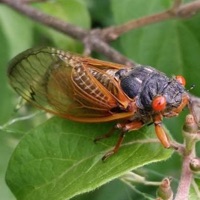
- Short Name: M. cassini
- Common Name: Cassini Periodical Cicada or 17-Year Cicada
- Locations: GA, IA, IL, IN, KS, KY, MD, MO, NC, NE, NJ, NY, OH, OK, PA, TN, TX, VA, WI, WV
- When: May-June. Peaks in June. Every 17 years.
- Eyes: reddish orange
- Collar: black
- Description: Black body with orange wings and legs.
- More info, photos, sounds, video, and references
Magicicada neotredecim Marshall and Cooley, 2000
©Insect Singers.
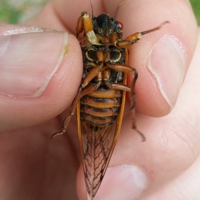
- Short Name: M. neotredecim
- Common Name: 13 Periodical Cicada or 13-Year Cicada
- Locations: AR, IA, IL, IN, KY, MO, TN
- When: May-June. Peaks in June. Every 13 years.
- Eyes: reddish orange
- Collar: black
- Description: Black body with orange wings and legs. Orange stripes on the abdomen. Orange between eye and wing.
- More info, photos, sounds, video, and references
Magicicada septendecim (Linnaeus, 1758)
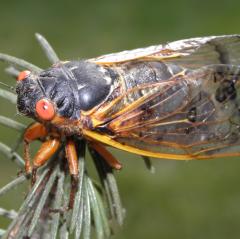
- Short Name: M. septendecim
- Common Name: Decim Periodical Cicada or Linnaeus’s 17-Year Cicada or 17-Year Cicada
- Locations: CT, DC, DE, GA, IA, IL, IN, KS, KY, MA, MD, MI, MO, NC, NE, NJ, NY, OH, PA, RI, SC, TN, VA, WI, WV
- When: May-June. Peaks in June. Every 17 years.
- Eyes: reddish orange
- Collar: black
- Description: Black body with orange wings and legs. Orange stripes on the abdomen. Orange between eye and wing.
- More info, photos, sounds, video, and references
Magicicada septendecula Alexander and Moore, 1962
© Joe Green.
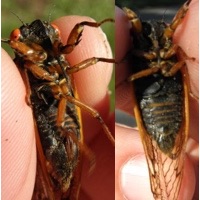
- Short Name: M. septendecula
- Common Name: Decula Periodical Cicdada or 17-Year Cicada
- Locations: GA, IA, IL, IN, KS, KY, MO, NC, NJ, NY, OH, OK, PA, TN, VA, WV
- When: May-June. Peaks in June. Every 17 years.
- Eyes: reddish orange
- Collar: black
- Description: Black body with orange wings and legs. Orange stripes on the abdomen.
- More info, photos, sounds, video, and references
Magicicada tredecassini Alexander and Moore, 1962
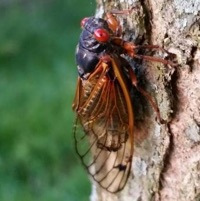
- Short Name: M. tredecassini
- Common Name: 13-Year Cicada or 13-Year Cassini
- Locations: AL, AR, GA, IA, IL, IN, KY, MD, MO, MS, NC, OH, OK, SC, TN, VA
- When: May-June. Peaks in June. Every 13 years.
- Eyes: reddish orange
- Collar: black
- Description: Black body with orange wings and legs.
- More info, photos, sounds, video, and references
Magicicada tredecim (Walsh and Riley, 1868)
©Insect Singers
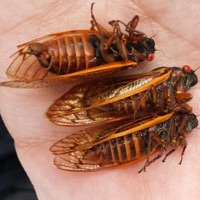
- Short Name: M. tredecim
- Common Name: 13-Year Cicada or 13-Year Decim
- Locations: AL, AR, GA, IL, IN, KY, LA, MD, MO, MS, NC, OH, OK, SC, TN, VA
- When: May-June. Peaks in June. Every 13 years.
- Eyes: reddish orange
- Collar: black
- Description: Black body with orange wings and legs. Orange stripes on the abdomen. Orange between eye and wing.
- More info, photos, sounds, video, and references
Magicicada tredecula Alexander and Moore, 1962
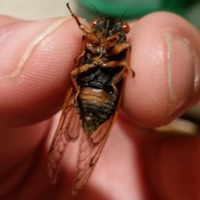
- Short Name: M. tredecula
- Common Name: 13-Year Cicada or 13-Year Decula
- Locations: AL, AR, GA, IA, IL, IN, KY, LA, MO, MS, NC, OH, OK, SC, TN, VA
- When: May-June. Peaks in June. Every 13 years.
- Eyes: reddish orange
- Collar: black
- Description: Black body with orange wings and legs. Orange stripes on the abdomen.
- >More info, photos, sounds, video, and references
Related Resources
Most sound files are Copyright of Insect Singers.
Maps: Biogeography of the Cicadas (Hemiptera: Cicadidae) of North America, North of Mexico [PDF]
Didn’t find what you’re looking for? Try these websites about the cicadas of North America, or these blog posts about the United States and Canada.
Click the images for larger versions, the species name, and the name of the photographer.
20 replies on “Common Cicadas of North America”
Why does poor Indiana get the WORST ones 🙁
Cicadas for last month: Clark Co, Indiana
green on shell immediately behind eyes, green wings closer to the thorax then turning brown toward the end of the wing; green upper legs
pictures available.
I have noticed a small camo colored species here in Central Texas. Insect is about 3/4 to 5/8″ in length. I have never seen a casing where one of these emerged. It would be quite small. What species is this? Are they new to my area for some reason or have they just eluded me all these years?
Cicadas are cool
I’m just now learning about Cicadas since my cat has started bringing them in to play with. I guess it’s better to be curious than grossed out.
the 17 year cicadas are out now in drives here in cincinnati ohuo. my friend and I noticed amount tgem a totally black one with black wings. I can send a photo if that would help. I did not see a photo of it here. any help identifying it would be helpful!
You can send photos to cicadamania@gmail.com
Found a small cicada in my backyard. About the size of a grapefruit seed. Had a strange hump on its back. Looked like part of the wing configuration. I got a picture of it but it moved and flew away. I live in florida, and as I know, we are not due to have any cicadas right now. Can anyone help me find out what kind of cicada species would look like this?
Email the photo to cicadamania@gmail.com.
I have a photo of a cicada that was rapping on my window one night. It sounded like someone tapping on the glass with their ring. It is closest to the M. septendecim or the M. tredecassini, but they don’t seem to be something you would find in Arizona. Also his red eyes were larger and more bulging. Can anyone help me identify him?
Also, is it common for them to rap on window panes?
@Jill — not common for them to rap on windows, although they might be after the light inside your home, thinking it’s the sun. Artificial light confuses them. Red eyes in Arizona sounds like Citrus Cicada aka Diceroprocta apache. Photo on this page.
Thank you so much! I grew up in the South where cicadas are just all over the place. Since this never happened to me back home, I was really surprised that this little guy turned up. Those flesh-colored legs threw me off. Thank you so much for telling me what he is. I appreciate it so much!
I really need help identifying a cicada found on our tree. I’m not finding it anywhere. I’ve searched a ton of websites and insect identification sites with no luck. I’m a master gardener and am trying to post this information with the photo on our Facebook page. Can you help me if I send you the photos? Thanks!
@Tracy, send your photos to cicadamania@gmail.com
Thank you. Somebody just identified it as the Grand Western Plain cicada.
I’ve seen people play cicadas with string bands before. They would catch one, then lightly squeeze it in a rhythmic way and it would chirp along with the music. The sound of summer
When I was a kid my mom didn’t know about cicadas so she told me it was the sound of the power lines. Boy, those power lines were sure noisy in the summer! I always wondered why they were quiet in the winter. It wasn’t until more recently that I realized that explanation made no sense and put the sound together with cicadas, which I only learned about after looking up what the pokémon nincada was based off of. (Who says videogames aren’t educational?) I believe it’s m. dealbatus we heard as I recently visited my childhood home and that’s the only species that lives in the area that sounds like what I heard there. I’ve outgrown games but I still have a hobby interest in insects thanks to that franchise.
I have found a bright green cicada in Pennsylvania today 7/23 first I have never found like it wondering if it is now moving in to this region hoping you can help
Mike, they’re normal for Pensy. What you’ve found is a cicada in its teneral state aka what it looks like just after molting. It’s probably one of the Neotibicen on this page, like the Neotibicen tibicen, Neotibicen linnei or Neotibicen pruinosis